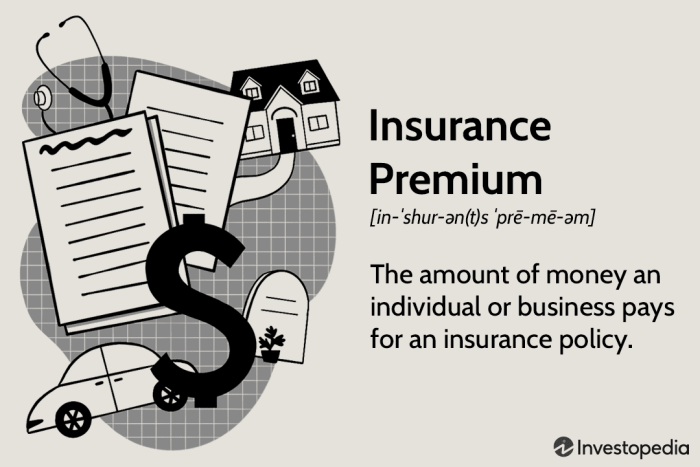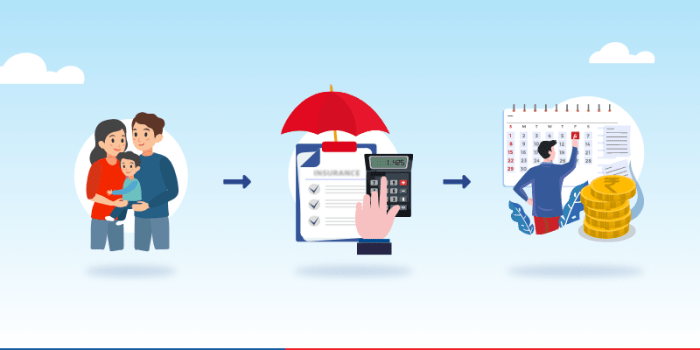Securing your future, protecting your assets, and mitigating risk—these are the cornerstones of insurance. But have you ever stopped to consider the very foundation upon which this security rests? The answer lies in understanding insurance premiums, the price we pay for the peace of mind that comes with coverage. This exploration delves into the multifaceted world of insurance premium definition, revealing the intricacies of calculation, payment, and the factors influencing this crucial cost.
From the fundamental concept of transferring risk to the complexities of actuarial science, this guide offers a clear and concise explanation of insurance premiums. We will unravel the components that contribute to your premium, explore the various payment methods, and examine how external factors can influence their fluctuation. Ultimately, understanding your insurance premium is key to making informed decisions about your financial protection.
Core Definition of Insurance Premium

An insurance premium is essentially the price you pay to an insurance company for a policy that protects you against financial losses. Think of it as a pre-paid fee for the peace of mind and financial security an insurance policy provides. It’s a crucial component of the insurance system, enabling insurers to cover claims and operate effectively.
Insurance premiums are the payments made by policyholders to an insurance company in exchange for coverage under an insurance policy. The amount of the premium is determined by several factors, as detailed below. A concise definition for a general audience would be: The regular payment made to an insurance company to maintain an insurance policy that covers potential financial losses.
Examples of Insurance Premiums
Different types of insurance policies carry different premium structures, reflecting the level of risk involved. For example, health insurance premiums are typically paid monthly and vary widely based on factors such as age, location, health status, and the chosen plan. Auto insurance premiums, also usually monthly, depend on factors like driving history, vehicle type, location, and coverage levels. Life insurance premiums, on the other hand, can be paid monthly, annually, or as a lump sum, and the amount is influenced by the policy’s death benefit, the insured’s age and health, and the policy type (term life, whole life, etc.).
Components of an Insurance Premium
Several factors contribute to the final premium amount. These factors are carefully analyzed by actuaries to assess risk and set appropriate pricing. The primary components typically include:
- Expected Claims Costs: This is the largest component, representing the insurance company’s prediction of how much it will have to pay out in claims for a specific group of policyholders. This prediction is based on statistical analysis of past claims data, considering factors like age, location, and the type of coverage.
- Operating Expenses: These are the costs the insurance company incurs to run its business, such as salaries, administrative costs, marketing, and commissions paid to agents.
- Profit Margin: Insurance companies, like any other business, aim to make a profit. A portion of the premium is allocated to ensure the company’s financial health and sustainability.
- Risk Assessment: The assessment of individual risk factors influences the premium. For example, a driver with a history of accidents will likely pay a higher auto insurance premium than a driver with a clean record. Similarly, a person with pre-existing health conditions might pay more for health insurance.
The total premium is the sum of these components, ensuring the insurer can meet its obligations to policyholders while maintaining profitability.
Factors Influencing Premium Calculation
Insurance premiums aren’t plucked from thin air; they’re meticulously calculated based on a complex interplay of factors. Understanding these factors provides valuable insight into the cost of insurance and how individuals can potentially influence their premiums. This section will delve into the key elements insurance companies consider when setting premium rates.
Risk Assessment in Premium Calculation
Risk assessment forms the cornerstone of premium calculation. Insurers employ sophisticated actuarial models to evaluate the likelihood of a claim occurring for a particular policyholder or group. This involves analyzing historical data, statistical modeling, and incorporating various risk factors specific to the type of insurance. A higher perceived risk translates directly into a higher premium, as the insurer needs to offset the increased probability of paying out a claim. For example, a driver with multiple speeding tickets will be assessed a higher risk than a driver with a clean record, leading to a higher car insurance premium. The accuracy and sophistication of these risk assessments directly impact the fairness and competitiveness of insurance pricing.
Premium Calculation Methods Across Different Insurance Types
Premium calculation methods vary significantly across different insurance types. For example, car insurance premiums often incorporate factors like vehicle type, driving history, location, and coverage levels. Home insurance premiums consider factors such as the home’s location, age, construction materials, and security features. Health insurance premiums, on the other hand, are heavily influenced by age, health status, pre-existing conditions, and the chosen plan’s coverage level. Life insurance premiums are primarily determined by age, health, lifestyle, and the chosen death benefit amount. While the underlying principle of risk assessment remains consistent, the specific factors and weighting given to each factor differ significantly depending on the type of insurance.
Impact of Individual Characteristics on Premiums
Individual characteristics play a significant role in determining insurance premiums. Age is a major factor across many insurance types; older individuals often face higher premiums for health and life insurance due to increased health risks. Similarly, health status significantly impacts health insurance premiums, with pre-existing conditions or unhealthy lifestyles resulting in higher costs. In car insurance, driving records are crucial, with accidents and violations leading to increased premiums. For home insurance, credit scores sometimes play a role, reflecting the perceived risk of timely premium payments. These factors are all used to create a risk profile for each individual, leading to a personalized premium.
Hypothetical Scenario Illustrating Premium Cost Variation
Consider two individuals applying for car insurance: Individual A is a 25-year-old with a clean driving record, driving a fuel-efficient sedan in a low-crime area. Individual B is a 40-year-old with two speeding tickets and an at-fault accident in the past three years, driving a high-performance sports car in a high-crime area. All else being equal (same coverage level, same insurer), Individual A would receive a significantly lower premium than Individual B. This difference reflects the higher perceived risk associated with Individual B’s profile—age, driving history, vehicle type, and location all contribute to a higher risk assessment and therefore a higher premium. This scenario highlights how seemingly minor differences in individual characteristics can result in substantial variations in insurance costs.
Premium and Policy Relationship

The insurance premium and the policy’s coverage are intrinsically linked; the premium paid determines the extent and type of protection offered. A higher premium generally corresponds to broader coverage, higher payout limits, or more comprehensive protection against various risks. Conversely, a lower premium often means more limited coverage or higher deductibles. Understanding this relationship is crucial for consumers to make informed decisions about their insurance needs.
The relationship between premium amount and policy benefits can be visualized as a seesaw. Imagine the seesaw’s fulcrum representing the policy itself. On one side, you have the premium amount – the weight you contribute. On the other side, you have the policy benefits – the potential payout or assistance received in case of a covered event. A heavier premium (more weight on one side) allows for a larger potential payout (more weight on the other side), representing greater coverage and protection. A lighter premium (less weight) results in a smaller potential payout (less weight), indicating less comprehensive coverage. The balance point represents the fair exchange between the cost of the premium and the value of the protection received.
Policy Features and Premium Costs
Policy features significantly impact the premium cost. For example, higher coverage limits (such as a higher liability limit on auto insurance or a higher death benefit on a life insurance policy) will generally result in higher premiums. Similarly, a lower deductible (the amount you pay out-of-pocket before the insurance coverage kicks in) will typically lead to a higher premium. Conversely, choosing a higher deductible often reduces the premium cost, as the insurance company’s financial risk is lowered. Additional features, such as roadside assistance on an auto policy or specific riders on a life insurance policy, also influence premium costs; each added feature increases the potential payout the insurer might have to make, leading to a higher premium. For instance, adding an earthquake coverage to a homeowner’s insurance policy in a high-risk zone will undoubtedly increase the premium.
Last Point

In conclusion, understanding insurance premium definition is paramount for navigating the world of financial security. By grasping the interplay between risk assessment, policy features, and external factors, individuals can make informed choices regarding their coverage. While premiums represent a cost, they are ultimately an investment in protection against unforeseen circumstances, ensuring financial stability and peace of mind in times of need. Remember to regularly review your policy and actively engage with your insurer to ensure you are receiving the most appropriate coverage at a fair price.
Answers to Common Questions
What happens if I miss an insurance premium payment?
Missing a payment can lead to policy cancellation or suspension of coverage, leaving you vulnerable to financial losses in the event of a claim. Late payment fees may also apply.
Can I negotiate my insurance premium?
While not always guaranteed, negotiating your premium is sometimes possible. This often involves shopping around for different insurers, highlighting your good driving record or health history, or bundling multiple policies.
How often are insurance premiums reviewed?
The frequency of premium reviews varies by insurer and policy type. Some policies have annual reviews, while others might adjust premiums more frequently based on factors like claims history or changes in risk assessment.
What is a premium credit?
A premium credit is a reduction in your overall premium, often offered as a reward for safe driving, good health, or bundling policies.